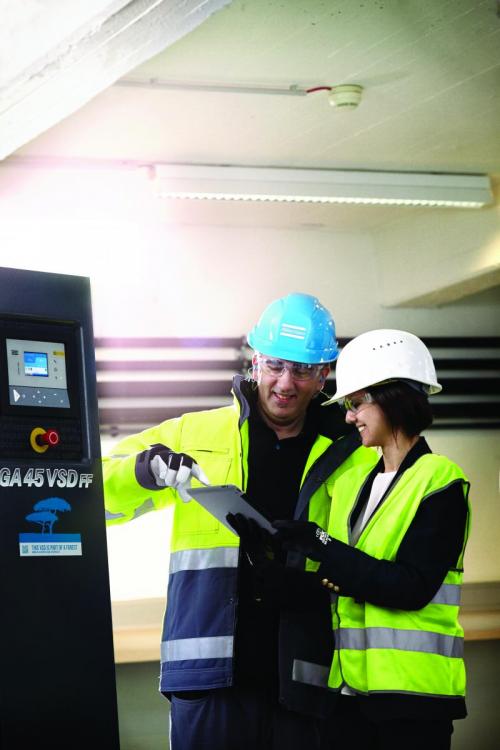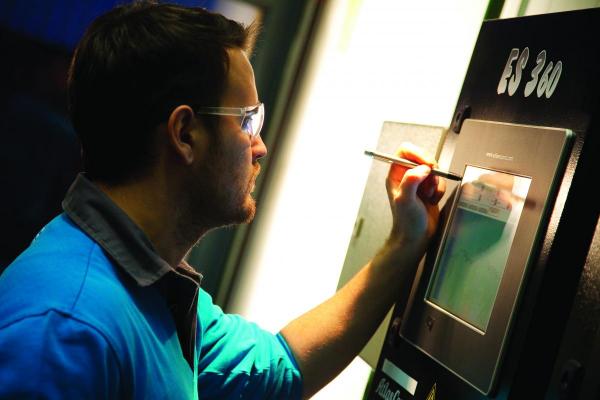Companies will experience periods of increased production, as well as periods of slower or stopped production. It’s the nature of being in business. Understanding the implications of these business shifts for compressed-air installations (the powerhouse behind a facility’s production) is key for ensuring that air compressors remain functional and efficient. Here are guidelines to ensure your facility’s compressed-air system operates at top performance, no matter the speed of production.
Guidelines for Increased Compressed Air Usage
Is the business in ramp-up mode? Don’t leave your compressed air installation out of the planning and prepping process. Your air compressor powers production throughout your facility, so preparing this equipment for heavy production is important to acceleration in production.
- Don’t forget about the air compressor. One of the most essential aspects of shifting gears is your compressed air system. Without compressed air, production can’t occur! Does the current air compressor have the capacity to keep up, and is it in shape to handle the demands that increased production brings on? Addressing these questions and keeping your compressed air system in mind prior to the increase in production will help mitigate issues down the road.
- Keeping up with demand. Are you buying an additional air compressor to keep up with increased demand? You might save money buying one large air compressor. Keep the old air compressor for backup – who knows when something unexpected may happen to the primary unit, which could cease production altogether.
- More compressed air = more downstream moisture. Is the system prepared to handle extra moisture the increase in compressed air will produce? Moisture can be detrimental to compressed air installations and end processes. Before ramping up production, determine whether the system’s drying methods (from integrated air dryers, aftercoolers, or over-compression) can compensate for more moisture in the system.
- Got enough storage? Air receiver tanks provide temporary storage the system can use during peak demands. Upgrading the storage will help ensure a sufficient supply of air while decreasing the number of starts experienced by the air compressor motor.
- Say hello to new technology. The last decade has seen a huge stride in compressed air technologies, especially with larger horsepower air compressors. Knowing the newest features and benefits of today’s compressed air technologies is important – especially if the air compressor is more than 10 years old.

It’s important to plan and prepare compressed air systems for heavy production when the business is in ramp-up mode.
Guidelines for Stopping or Pausing Air Compressor Installations
Need to reduce production and switch off air compressors temporarily? If production is stopping, manually stop the air compressor - even if it is integrated into a central controller. If you don’t, the machine might run at minimal capacity to compensate for small leaks in your compressed-air network.
- Variable Speed Drive (VSD) air compressors. Carry out a program stop. Make sure the electrical-power supply is left on to keep the capacitor bank charged and ready for restart.
- Water-cooled air compressors. After stopping the air compressor, isolate the water supply. This will stop condensation from forming inside the compressor element(s). Remember to turn it back on at start up! Ensure that any air-blast cooling systems are turned off.
- Oil-free air compressors. The main drive shaft needs to be manually rotated via the motor drive coupling, three complete rotations, once a week. This is to prevent the low- and high-pressure compression stages from seizing up during a long period of downtime. If the air compressor is a VSD version, turn the power supply back on after turning the air compressor over by hand to protect the inverter drive capacitors.
- Centrifugal air compressors. Carry out a program stop and leave the power supply on. They need to have the auxiliary oil pump left turned on electrically while the air compressor is shut down. This will maintain the oil temperature and periodically start up the auxiliary oil pump to circulate warm oil around the bearings during long periods of downtime.
- Gas generators and dryers (adsorption or refrigerant). These can be stopped manually and depressurized if required. When depressurizing gas generators, monitor the oxygen level in the machine room.

Be sure to follow the appropriate procedures when stopping or pausing air compressors.
Guidelines for Restarting an Air Compressor Installation
- Turn off the power supply to the air compressor.
- Remove the drive shaft protection guard and turn the drive coupling to check that the air compressor is free to turn. If the air compressor turns freely, re-fit the guard and turn on the power supply to the air compressor.
- Turn on the cooling water and air blast cooling system (if the air compressor is water cooled).
- Close the air compressor air discharge valve and start the air compressor.
- Slowly open the air-discharge valve until the air pressure equalizes between the air compressor and the air net. At this point the air compressor is back online.
Note: If the air compressor is connected to a sequence controller, ensure the air compressors are integrated onto the controller or optimizer.
How to Save on Energy Costs During Slower Production Periods
One benefit of reduced production is the potential for significant savings on monthly energy costs. Because compressed air accounts for a large amount of a plant’s total energy costs, decreased production (and therefore decreased compressed air usage) can have a positive impact. Here’s a look at energy-saving opportunities.
1. Reduced unloaded running hours. Air demand in an industrial compressed air system fluctuates. Use this fluctuating demand to reduce unloaded running hours to optimizing energy efficiency.
- Air compressor controllers. These provide user-friendly ways to reduce unloaded running hours. If you have multiple air compressors, then the controller has likely been set up to do this automatically. If there is no central controller, then the air compressor pressure bands have probably been set up in a cascade method. This means that when the target air pressure is reached, the on-board controllers will stop the machines. If air compressors are left running unloaded after working hours, they still use as much as 25% of the energy consumed at full load. If there are leaks in the system, the air compressors may switch to loaded running occasionally, consuming even more energy.
- Turning air compressors off. As referenced earlier, the shorter the production time, the more energy costs may be saved by switching air compressors off instead of letting them run unloaded. If production is reduced but not stopped, consider isolating unused areas of the factory and update your plan accordingly.
2. Eliminating air leaks. If the air compressor installation is older, air leaks can be a huge source of wasted energy. As much as 20% of total compressed air consumption could be lost through leaks – and 80% of air leaks aren’t even audible. If you’re still on-site and have time available, take the opportunity to check for leaks in your system. Doing so could save you money.
3. Reduced pressure band. As a rule of thumb for most air compressors, a reduction of 1% PSI will lead to a 2% savings in energy. The pressure settings of the air compressor should be adjusted until the lowest pressure can be reached and the pressure band reduced without affecting the application. If your air compressor installation has a centralized system responsible for multiple controllers, the network can be set to run within a narrow pressure band – ensuring that the compressed air network matches your precise needs. The controller can also allow you to manually or automatically create two different pressure bands to optimize energy use within different periods, drastically reducing energy costs at low-use times.
4. Energy recovery. One area that offers manufacturers a significant opportunity for savings is to recover the waste heat from air compressors. Without energy recovery, this heat is lost into the atmosphere through the cooling system and radiation. The amount of electrical energy that can be recovered depends on the size of the air compressor and the running hours. Typical recoveries are between 70-94 percent. Recovering heat from compressed air reduces the need for purchasing energy, which results in lower operating costs and CO2 emissions. For example, you can produce hot water for washrooms or direct warm air into a workspace, warehouse, loading dock, or entryway. The savings can really add up.
5. Ensure the right air compressor type is Installed. Most production processes require different levels of demand in different periods, which could mean the air compressor is running off-load or idle for long periods. You can attain great savings if a fixed-speed air compressor can be replaced by a VSD unit, as it produces compressed air only as required. This also minimizes offload running of the air compressor.

A slow production period often represents an opportunity to save energy on the operation’s compressed air system.
Take the Guesswork Out of It
Compressed air should never rely on guess work. There are a range of tools and services that are completely free of charge that can help you benchmark efficiency, find ways to expand, or ensure efficiency during a slowdown in demand.
The key thing to remember is that any investment should come with a clear payback and ROI. If you don’t get one, then don’t purchase! From a cost and finance point of view, it could be argued there has never been a better time to make an investment in your air system. Often, the monthly cost for a new air compressor is less than the monthly savings, so the air compressor contributes to the bottom line from day one. If you think you’ve got the wrong machine for your needs, then there is no need to feel that you must live with it.
About Atlas Copco Compressors, LLC.
Atlas Copco Compressors LLC is part of the Compressor Technique Business Area, headquartered in Rock Hill, South Carolina. Atlas Copco Compressors provides innovative solutions including world-class compressors, vacuum pumps, air blowers, quality air products and gas generation systems, all backed with full service, remote monitoring and auditing services. With a nationwide service and distribution network, Atlas Copco Compressors is your local, national and global partner for all your compressed air needs. Learn more at www.atlascopco.com/air-usa.
All photos courtesy of Atlas Copco Compressors.
To read more Air Compressor Technology articles, visit www.airbestpractices.com/technology/air-compressors.




